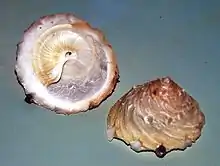Onustus caribaeus
Onustus caribaeus is a species of large sea snail, a marine gastropod mollusk in the family Xenophoridae, the carrier shells.[1]
| Onustus caribaeus | |
|---|---|
 | |
| Onustus caribaeus shells | |
| Scientific classification | |
| Kingdom: | |
| Phylum: | |
| Class: | |
| (unranked): | |
| Superfamily: | |
| Family: | |
| Genus: | |
| Species: | O. caribaeus |
| Binomial name | |
| Onustus caribaeus (Petit de la Saussaye, 1857) | |
| Synonyms[1] | |
| |
Description
The anatomy of O. Caribaeus. is very similar to all members of the Xenophoridae family. Their shells have a flat bottom and a short conical spiral on top.[2] They are known for their ability to camouflage by attaching substrates like pebbles, sand, empty shells, and even coral to the top of their shells.[3] The specifics of how this is done are not known.[4] However, we know that these foreign objects are fused to the shells in all different conformations, radially, laterally, or symmetrically as the shell grows.[5] The shells can reach a maximum height of 45 mm, in average 37 mm. The diameter of the base reaches a maximum length of 88 mm, in average 60 mm. The colour of the dorsum is yellowish-white.[6] Like other snails, O. Caribaeus have a radula, used for scraping detritus and other substances off of substrates to feed on, and a muscular foot used for locomotion.[7]
Distribution
Onustus caribaeus is distributed in the North-eastern Gulf of Mexico, the Caribbean Sea and along the Atlantic coast of Brazil between 35m and 640m (mostly deeper than 100m).[6]
References
- Onustus caribaeus (Petit de la Saussaye, 1857). WoRMS (2010). Onustus caribaeus (Petit de la Saussaye, 1857). Accessed through: World Register of Marine Species at http://www.marinespecies.org/aphia.php?p=taxdetails&id=468051 on 9 July 2010 .
- "THE ADAPTATIONS AND RELATIONSHIPS OF THE XENOPHORIDAE (MESOGASTROPODA)". Journal of Molluscan Studies. December 1958. doi:10.1093/oxfordjournals.mollus.a064812. ISSN 1464-3766.
- Beu, A. G. (June 1977). "New Zealand Cenozoic Gastropods of the genus Xenophora Fischer, 1807". Journal of the Royal Society of New Zealand. 7 (2): 229–241. doi:10.1080/03036758.1977.10427161. ISSN 0303-6758.
- Crippa, Gaia; Pasinetti, Giovanni; Dapiaggi, Monica (October 2020). "How did the carrier shell Xenophora crispa (König, 1825) build its shell? Evidence from the Recent and fossil record". Lethaia. 53 (4): 439–451. doi:10.1111/let.12367. ISSN 0024-1164.
- Feinstein, Noah (1998). "Learning from the Collector: A Survey of Azooxanthellate Corals Affixed by Xenophora (Gastropoda: Xenophoridae), with an Analysis and Discussion of Attachment Patterns". Nautilus. 112: 73–83.
- Kreipl, K. & Alf, A. (1999): Recent Xenophoridae. 148 pp. incl. 28 color plts. ConchBooks, Hackenheim, ISBN 3-925919-26-0.
- Arquivos de Zoologia. Universidade de Sao Paulo, Agencia USP de Gestao da Informacao Academica (AGUIA).
- Onustus caribaeus (Petit de la Saussaye, 1857). WoRMS (2010). Onustus caribaeus (Petit de la Saussaye, 1857). Accessed through: World Register of Marine Species at http://www.marinespecies.org/aphia.php?p=taxdetails&id=468051 on 9 July 2010 .
- J. E. MORTON, THE ADAPTATIONS AND RELATIONSHIPS OF THE XENOPHORIDAE (MESOGASTROPODA), Journal of Molluscan Studies, Volume 33, Issue 3, December 1958, Pages 89–101, https://doi.org/10.1093/oxfordjournals.mollus.a064812
- A. G. Beu (1977) New Zealand Cenozoic Gastropods of the genus Xenophora Fischer, 1807, Journal of the Royal Society of New Zealand, 7:2, 229-241, DOI: 10.1080/03036758.1977.10427161
- Crippa, Pasinetti, G., & Dapiaggi, M. (2020). How did the carrier shell Xenophora crispa (König, 1825) build its shell? Evidence from the Recent and fossil record. Lethaia, 53(4), 439–451. https://doi.org/10.1111/let.12367
- Feinstein, & Cairns, S. D. (1998). Learning from the collector: A survey of azooxanthellate corals affixed by Xenophora (Gastropoda: Xenophoridae), with an analysis and discussion of attachment patterns. The Nautilus (Philadelphia).
- Kreipl, K. & Alf, A. (1999): Recent Xenophoridae. 148 pp. incl. 28 color plts. ConchBooks, Hackenheim, ISBN 3-925919-26-0
- Arquivos de zoologia. (1967). Museu de Zoologia da Universidade de São Paulo.
External links